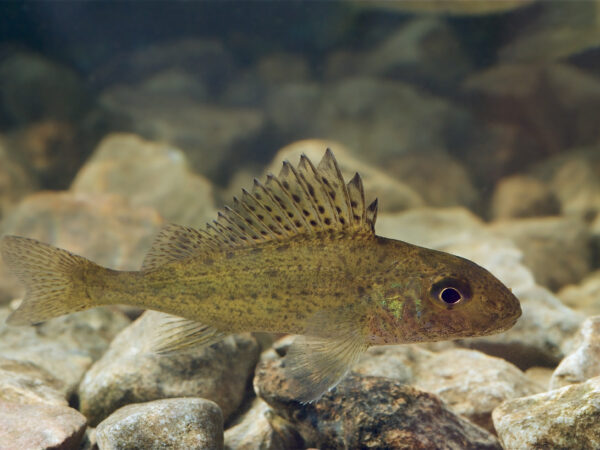
Eurasian Ruffe
(Gymnocephalus cernuus)
Species at a Glance
The Eurasian Ruffe is a small but aggressive member of the perch family. Its prolific growth, reproduction, and ability to adapt to a wide range of environments make it a serious threat to both aquatic environments and commercial and sport fishing industries.
Species Description
The Eurasian Ruffe has a small, deep, and laterally compressed body, typically measuring 10–15 cm (4–6 in) in length, though some individuals can grow over 25 cm (10 in). It resembles a Yellow Perch but can be distinguished by its lack of head scales and walleye-like markings. Its coloration ranges from greenish-brown on the back to lighter brown sides with irregular dark patches. The body is coated in a slimy mucus, and the sharp spines on the dorsal fin and gill covers serve as effective deterrents to predators, making it an unappealing target.
Native & Introduced Ranges
Native to the fresh and brackish water areas of Eurasia, the Eurasian Ruffe was introduced into Lake Superior in the mid-1980s. It likely escaped during the release of ballast water carried by ships. Since then, it has continued to spread throughout the upper Great Lakes and has significantly increased in the St. Louis River near Duluth, Minnesota. Ballast water release is also likely responsible for its movement from lake to lake, making expansion into the lower Great Lakes likely.
Biology & Spread
The Eurasian Ruffe grows and matures quickly, with females reaching reproductive maturity at two years of age and males after just one year. It can spawn in a wide range of temperatures, habitats, and on just about any substrate. It is an opportunistic feeder, preying on aquatic insects, bottom dwelling organisms, and occasionally the eggs of other fish. The Eurasian Ruffe has few predators.
Habitat
The Eurasian Ruffe can tolerate a wide range of environmental conditions including degraded waters and varying salinities, depths, and nutrient levels. Its adaptability enables it to survive in a variety of habitat types including lakes, large and small rivers, estuaries, and ponds.
Impacts
Threat to Biodiversity
Once introduced, populations of the Eurasian Ruffe can grow quickly, reducing the availability of food and habitat for native fish. It has a competitive advantage over native fish due to its early maturity, high reproductive rate, and ability to adapt to new environments. In areas where the Eurasian Ruffe has become established, populations of Yellow Perch, Walleye, and a number of small forage fish have declined. The Eurasian Ruffe is able to detect minute vibrations through a highly developed sensory system, giving it the ability to avoid predators and find prey in dark waters.
Prevention & Control
Preventing the introduction and spread of the Eurasian Ruffe is the best way to protect natural habitats from harm.
- Know how to identify and report the Eurasian Ruffe.
- Always check for and remove plants, mud, and debris from boats, trailers, clothing, and equipment before entering a water body and before leaving a water body.
- Drain all water from bait buckets, bilges, and live wells before transporting to new areas.
- Clean all gear and equipment with hot water (140°F or 40°C) or salt water, OR let boats and equipment dry thoroughly for at least five days before entering a new water body.
- Unused live bait should be disposed of in the trash; it is unlawful in Pennsylvania to release any unused live bait.
References:
- Fuller, P.G., Jacobs, J., Larson, and Fusaro, A. 2012. Gymnocephalus cernuus. USGS Nonindigenous Aquatic Species Database. Gainesville, FL.
- Hajjar, R. 2002. Introduced species summary project: Ruffe (Gymnocephalus cernuus). Columbia University.



